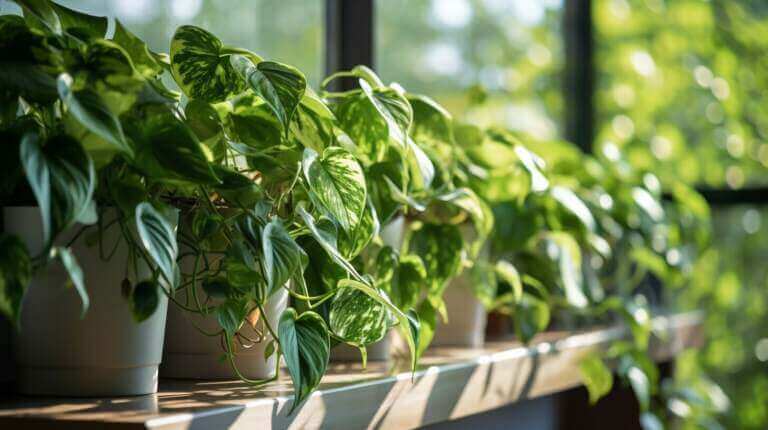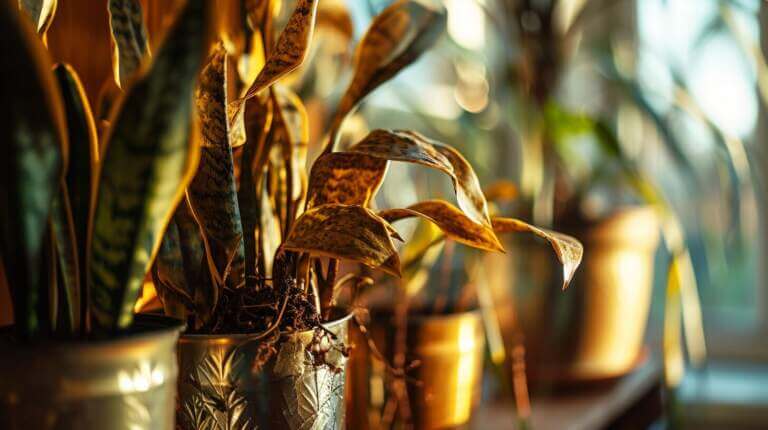Repotting String of Pearls Plants Guide: When to Transplant and How to Do It Right
String of Pearls plants, also known as Senecio rowleyanus or Curio rowleyanus, are popular succulent houseplants with a shallow root system. Repotting is necessary when the plant becomes root-bound or overcrowded.
The best time to repot is during the spring or summer months. When repotting, choose a pot that is only one size larger than the current one to prevent excess moisture retention. Ensure the pot has drainage holes to avoid root rot. Use a well-draining soil mix, such as a cactus or succulent mix, or create your own by combining potting soil with sharp sand. Be gentle when handling the delicate stems and pearls during repotting.
Key Takeaways:
- Repot string of pearls plants when root-bound or overcrowded
- Best time to repot is during spring or summer
- Choose a pot one size larger with drainage holes
- Use well-draining soil mix or create your own
- Handle the plant gently during repotting
When to Repot String of Pearls Plants
The best time to repot string of pearls plants is during the spring or summer months when the plant is actively growing. This is when it has the highest chance of successfully adjusting to its new pot. Repotting during the warmer months also allows the plant to benefit from increased sunlight and warmth, aiding in its recovery after being disturbed. If you live in a more moderate climate, repotting in the early fall months is also acceptable. Avoid repotting during winter when the plant is dormant and less likely to recover well.
Repotting string of pearls plants at the right time is crucial for their overall health and growth. By choosing the appropriate season, you provide the plant with optimal conditions for root development and establishment in its new pot. This ensures a successful transition and minimizes the stress on the plant.
Table: Ideal Repotting Time for String of Pearls Plants
| Season | Best Time to Repot |
|---|---|
| Spring | When the plant is actively growing and temperatures are mild |
| Summer | When the plant is in full growth and can recover quickly from any stress caused by repotting |
| Early Fall | For moderate climates where summer temperatures may be too harsh |
| Winter | Avoid repotting during winter as the plant is dormant and less likely to recover well |
How to Choose the Right Pot for Repotting String of Pearls Plants
Choosing the right pot is crucial when repotting string of pearls plants. The pot should have drainage holes to prevent excess moisture retention, which can lead to root rot. Terracotta or unglazed ceramic pots are ideal choices as they provide good airflow and help wick away excess moisture from the soil. These pots also have a natural appearance that complements the unique beauty of string of pearls plants.
When selecting a pot, it’s important to consider the size. The new pot should only be one size larger than the current one to prevent excessive moisture retention. The shallow root system of string of pearls plants does not require deep pots. Instead, opt for wider pots that can accommodate the spreading nature of the plant’s stems and pearls. This provides ample room for growth and reduces the risk of overcrowding.
| Pot Material | Advantages | Disadvantages |
|---|---|---|
| Terracotta | Good airflow, wicks away excess moisture | Can be fragile and break easily |
| Unglazed Ceramic | Provides good airflow, visually appealing | May be heavier and more expensive |
| Plastic | Lightweight, affordable | May retain moisture if not properly drained |
| Concrete | Durable, visually appealing | Can be heavy and difficult to move |
Selecting the Right Soil Mix for Repotting String of Pearls Plants
Choosing the right soil mix for repotting your string of pearls plants is crucial to their overall health and well-being. These succulents require a well-draining soil mix to prevent root rot and ensure optimal growth.
A cactus or succulent soil mix is an excellent choice for repotting string of pearls plants. These soil mixes are specifically formulated to provide the proper drainage and aeration that succulents need. They typically consist of a blend of organic materials like peat moss or coconut coir, sand, and perlite or pumice. This combination helps to create a lightweight and porous soil that allows excess water to drain away quickly, preventing waterlogged roots.
If you prefer to create your own soil mix, you can combine regular potting soil with sharp sand in a ratio of 3 parts soil to 1 part sand. The sand helps improve drainage and prevents the soil from becoming too compacted. This DIY mix can work well for string of pearls plants, but it’s important to ensure that it is well-draining and not too heavy.
Steps to Repotting String of Pearls Plants
Repotting string of pearls plants is a straightforward process that requires careful handling and attention to detail. Follow these steps to ensure a successful repotting:
- Prepare the new pot: Fill the new pot halfway with a well-draining soil mix, such as a cactus or succulent mix.
- Remove the plant from its old pot: Gently tap the bottom of the pot to loosen the plant’s roots. Carefully lift the plant out, taking care not to damage the delicate stems and pearls.
- Shake off excess soil: Remove any loose soil from the roots of the plant. This will help prevent the new pot from becoming too compacted.
- Trim dead roots and stems: Inspect the roots and stems for any signs of rot or damage. Trim off any unhealthy parts with a sterilized cutting tool.
- Place the plant in the new pot: Position the plant in the center of the new pot, making sure it is upright and stable. Fill in the gaps around the rootball with the soil mix, leaving about a quarter to half an inch of space below the rim of the pot.
- Lightly press down the soil: Gently press down on the soil to eliminate any air pockets and ensure the plant is firmly anchored.
- Water the plant: Give the plant a thorough watering, allowing the water to soak through the soil. Be careful not to overwater, as excessive moisture can lead to root rot.
- Find the perfect spot: Place the repotted plant in a bright location with indirect sunlight. String of pearls plants thrive in bright, filtered light.
Table: Common Mistakes to Avoid When Repotting String of Pearls Plants
| Mistake | Consequence | Prevention |
|---|---|---|
| Using a pot without drainage holes | Excess moisture retention, leading to root rot | Choose a pot with drainage holes to allow water to escape |
| Using a pot that is too large | Excessive moisture retention and slow root growth | Choose a pot that is only one size larger than the current one |
| Using regular potting soil | Poor drainage and increased risk of root rot | Use a well-draining soil mix or create your own succulent mix |
| Overwatering after repotting | Root rot and stress on the plant | Water thoroughly but allow the soil to dry out before watering again |
Aftercare Tips for Repotted String of Pearls Plants
Proper aftercare is essential to ensure the health and vitality of your newly repotted string of pearls plants. Following these tips will help your plants thrive:
- Provide adequate sunlight: Place your repotted string of pearls plant in a bright location where it can receive at least 6 to 8 hours of bright, indirect sunlight each day. East-facing windows or spots with filtered light are ideal.
- Maintain optimal temperature: Keep the plant in an environment with temperatures between 70 and 80 degrees Fahrenheit. Avoid exposing it to cold drafts or frost, as string of pearls plants are sensitive to low temperatures.
- Water appropriately: Water your repotted string of pearls plant thoroughly when the top inch of soil becomes dry. Be cautious not to overwater, as this can lead to root rot. Allow the soil to dry out between waterings, especially during the winter months when the plant goes into dormancy.
- Prune as needed: Regularly inspect your repotted string of pearls plant for any dead or unhealthy stems. Prune them back to promote new growth and maintain the plant’s desired shape. Remember to use sterilized pruning tools to prevent the spread of disease.
- Fertilize with care: Feed your repotted string of pearls plant with a balanced liquid or water-soluble fertilizer diluted to half strength. Apply the fertilizer every two weeks during the growing season and reduce the frequency during the winter months.
By providing the right amount of light, temperature, water, pruning, and fertilization, you can ensure the health and longevity of your repotted string of pearls plants.
| Aftercare Tips for Repotted String of Pearls Plants |
|---|
| 1. Provide adequate sunlight |
| 2. Maintain optimal temperature |
| 3. Water appropriately |
| 4. Prune as needed |
| 5. Fertilize with care |
Propagating String of Pearls Plants
Propagating string of pearls plants is a simple and rewarding way to expand your succulent collection. By following a few steps, you can create new plants and share the beauty of these unique succulents with others.
To begin propagating string of pearls, take stem cuttings of about 4 to 5 inches in length, just below a leaf node. Remove the lower two leaves to create a bare stem. Allow the cuttings to callous over and dry for one to two days.
Next, prepare a well-draining soil mix and fill a pot, creating a hole in the center. Insert the cuttings into the hole, leaving the top leaves above the soil and ensuring the bare stem is in contact with the soil. Pack the soil around the cuttings and water lightly. Place the pot in a bright spot with indirect sunlight and water the soil when it becomes dry.
| Steps to Propagate String of Pearls Plants |
|---|
| 1. Take stem cuttings of about 4 to 5 inches in length, just below a leaf node. Remove the lower two leaves to create a bare stem. |
| 2. Allow the cuttings to callous over and dry for one to two days. |
| 3. Fill a pot with a well-draining soil mix, creating a hole in the center. |
| 4. Insert the cuttings into the hole, leaving the top leaves above the soil and ensuring the bare stem is in contact with the soil. |
| 5. Pack the soil around the cuttings and water the soil lightly. |
| 6. Place the pot in a bright spot with indirect sunlight and water the soil when it becomes dry. |
| 7. Within three to four weeks, the cuttings should take root and start growing new plants. |
How Often to Repot String of Pearls Plants
Knowing when to repot your string of pearls plants is crucial to their long-term health and growth. These plants have a shallow root system that allows them to stay in the same pot for several years. However, there are certain indicators that signal it’s time to repot.
One key factor is root-boundness, which occurs when the roots tightly fill up the pot and start circling around. This restricts the plant’s growth and indicates that it needs more space to thrive. Another sign is when the potting mix becomes exhausted and unable to provide the necessary nutrients for the plant.
On average, repotting your string of pearls plant once every 5 years is sufficient to maintain its health and promote optimal growth. However, it’s important to closely monitor the plant and assess its condition regularly. If you notice signs of stress, overcrowding, or restricted growth, repotting may be necessary before the 5-year mark.
FAQ
When is the best time to repot string of pearls plants?
The best time to repot string of pearls plants is during the spring or summer months when the plant is actively growing. This allows it to adjust to its new pot more easily. Repotting in the early fall months is also acceptable in moderate climates. Avoid repotting during winter when the plant is dormant.
How do I choose the right pot for repotting string of pearls plants?
When repotting string of pearls plants, choose a pot that has drainage holes to prevent root rot. The pot should only be one size larger than the current one to prevent excess moisture retention. Terracotta or unglazed ceramic pots are recommended for good airflow and moisture control. Avoid deep pots and opt for wider pots to accommodate the shallow root system.
What soil mix should I use for repotting string of pearls plants?
String of pearls plants require a well-draining soil mix. A cactus or succulent soil mix is an excellent choice. If creating your own mix, combine potting soil with sharp sand in a ratio of 3 parts soil to 1 part sand. Avoid using regular potting soil as it retains more water than succulents prefer. Lighten commercial succulent mixes with perlite or pumice if needed.
What are the steps to repotting string of pearls plants?
1. Prepare the new pot with well-draining soil halfway full. 2. Gently remove the plant from its old pot, being careful not to damage the stems and pearls. 3. Shake off excess soil and trim any unhealthy roots or stems. 4. Place the plant in the new pot and fill in around the rootball with soil mix, leaving space below the rim. 5. Lightly press down on the soil and water thoroughly. 6. Place the repotted plant in a bright location with indirect sunlight.
What are some aftercare tips for repotted string of pearls plants?
1. Provide 6 to 8 hours of bright, indirect sunlight per day. 2. Maintain a temperature between 70 and 80 degrees Fahrenheit. 3. Water thoroughly when the top inch of soil is dry and allow it to dry out between waterings. 4. Prune dead or unhealthy stems as needed. 5. Fertilize with a diluted balanced liquid or water-soluble fertilizer biweekly during the growing season.
How do I propagate string of pearls plants?
1. Take stem cuttings of about 4 to 5 inches in length, removing the lower two leaves. 2. Allow the cuttings to callous over for one to two days. 3. Plant the cuttings in a well-draining soil mix with the bare stems in contact with the soil. 4. Keep the soil lightly watered and place the pot in a bright spot with indirect sunlight. 5. The cuttings should root and start growing new plants within three to four weeks.
How often should I repot string of pearls plants?
String of pearls plants do not need frequent repotting. On average, repotting once every 5 years is sufficient. However, monitor the plant closely for signs of stress or overcrowding and repot as needed.







